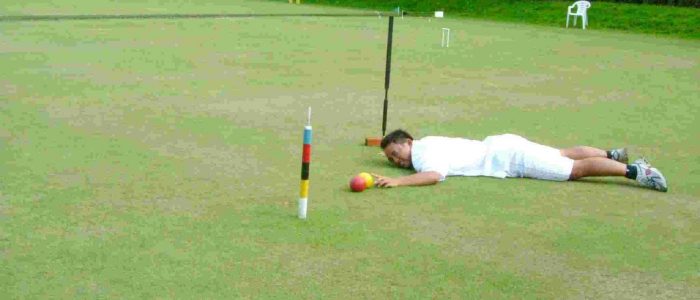This section explains how to complete your handicap card and how your handicap is managed by the Automatic Handicap System (AHS). You will need to refer to a Handicap Card.
Completing the card after each game.
Note that results of doubles games must not be entered.
In the OPPONENT column, enter the name of your opponent.
In the Hcp column, enter your opponent’s handicap.
In the h/l column, enter H if it is a handicap game, L if is a level play game (i.e. no bisque allowance even if the two players handicaps differ.
In the Res column, enter the margin of victory or defeat followed by T if the game finished when time ran out rather than the winner pegging out. Thus if you win a 26 point game by pegging out with your opponent scoring 17 points, enter +9. If you lose an 18 point game by scoring 12 points against your opponent’s 15, enter -3T.
In the +/- column, enter +10 if you win a handicap game, -10 if you lose a handicap game. If it is a level play game, calculate the number of handicap steps between you and your opponent. This is best done by looking at the table of Handicap Trigger Points on the handicap Card as handicaps are reduced in steps of two from 24 down to 12, in steps of one from 12 down to five and in steps of a half from five downwards. For example, there is one step between 12 and 14, two steps between 10 and 12 and six steps between 3 and 7. Now consult the Level Play Index Change v Handicap table on the card. This shows the number of index points to be added or subtracted. In our three examples, if a 12 plays a 14 and wins (one handicap step difference), the 12 gains 9 index points and the 14 loses 9 index points. If the 14 wins, he gains 11 index points and the 12 loses 11 index points. When the 10 plays the 12 (two handicap steps difference), if the 10 wins they gain or lose 8 Index points but if the 12 wins they gain or lose 12 index points. When the 3 plays the 7, if the 3 wins they gain or lose 4 index points but if the 7 wins they gain or lose 16 index points.
In the New column, enter the sum of your previous Index value and the index change entered in the previous column.
In the margin, it is becoming increasingly common (though not required) for players to initial the entry on their opponents handicap cards.
The Automatic Handicap System (AHS)
When you are first assigned a handicap you will also be given an Index value, usually the trigger point value for that handicap. It will be written on the front of the card. Have a look at the table of Handicap Trigger Points on the card. Thus a handicap of 24 has a trigger point of 850 index points, a handicap of 22 has an Index value of 900 and so on. As you play games your index goes up and down as you win and lose. If you start at 850 and then reach the next trigger point of 900, your handicap goes down from 24 to 22. Now win another handicap game and you index goes to 910 then lose one and you index goes back to 900. Now you lose another handicap game and your index drops to 890. Your handicap stays at 22. When you reach or pass through a trigger point your handicap only changes if it is different to the handicap associated with that index point. In this case your index would have to go down to 850 in order for your handicap to go back to 24.
When the AHS changes your handicap you should start playing off your new handicap immediately (but see below) and you should ask a member of the handicap committee to check and initial you card as soon as possible.
The exception to this is if you are playing in an event that lasts several games, for example a league match or a tournament. Your handicap changes at the end of the event, but only if your index value at that time still requires it.
Doubles
Although the results of doubles games are not recorded on the card, handicap doubles games are played and bisque allocations have to be calculated. The calculation was as follows: calculate the average handicap of each pair. Take one from the other and that is the bisque allocation. Round to the nearest half bisque if necessary.
The CA website
For details of the doubles handicapping regulations or to clarify any point which is not clear or to obtain a second explanation, readers are recommended to go to the CA website and click on Association Croquet on the home page and then explore the Handicapping section.





























